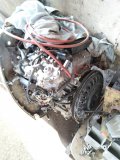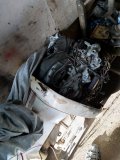IGNITION AND ELECTRICAL SYSTEMS 4-39
CllL T
TESTING
+ See Figure 79
Before testing, make sure all connections and mounting bolts are
clean and tight. Many charging system problems are related to loose
and corroded terminals or bad grounds. Don't overlook the engine
ground connection to the body.
Since most statorlbattery charge coil test values are near or below
1 ohm, testing requires the use of a high quality Digital Volt Ohmmeter
(DVOM). As with all resistance testing, care must be taken as specifications
are determined by testing components that are preciselv 68QF (20%) and
readings taken on components at other temperatures ill vary. Also, keep in
mind that certain intermittent ~roblems(s uch as certain internal shorts\
might only appear when the coil is put under a load during normal ope;ation
or at certain operating temperatures. Therefore, dynamic checks such as
those provided under the Charging System Running Output Test and
Charging System Quick Test may show problems that do not surface when
only conducting a resistance check.
During testing the coil winding resistance is checked across various
combinations of the stator coil wiring (yellow or yellow with trace color wires)
in order to see if the circuit contains the proper amount of resistance and is
therefore complete, yet containing no internal shorts between coils. On
FlCHT motors, both the 12-volt and the 26- or 40-volt windings of the stator
must be checked separately. On these motors the 12-volt leads are yellow or
yellow with trace colors while the 26- or 40-volt leads are usually brown or
brown with trace colors (or they are yellow wires of different lengths,
depending on the model). In all cases, each stator lead is then checked
between the coil and a good engine ground to make sure no coil winding is
shorted to around. If oDens or shorts are found. the wirina harness should
be checkeifor damage (when present, visible signs of bhken or worn
insulation are usually the cause of the problem) before deciding to replace
the coil itself,
Carbureted Motors
+ See Figure 79
1. Disconnect the negative battery cable for safety and to protect the
test equipment.
2. Locate the yellow (and yellow with a trace color) wiring for the stator.
Trace the wiring from under the edge of the flywheel to the harness or
terminal board connectors, as applicable.
3. Disconnect the stator battery charge circuit wiring from the terminal
board or disengage the harness connector, as applicable, for access while
testing with the DVOM. Inspect the terminals for corrosion or damage and
clean or replace them, as necessary.
As usual on outboards, take note of wire routing before
disconnecting them. Wires must always be returned to the original
positionlrouting in order to prevent interference with and damage
from moving components.
4. Using the DVOM set to its lowest resistance scale, connect one
meter probe to the yellow and the other meter probe to the yellowlgray wire
an.d c ompare the readings to specification, as follows: 6-amp charging systems resistance should be 1.2-1.7 ohms.
9 or 10-amp charging systems resistance should be 0.65-0.75
ohms.
20-amp charging systems resistance should be 0.175-0.195 ohms.
35-amp charging systems on 60° powerheads resistance should
be 0.05-0.19 ohms.
35-amp charging systems on 90° powerheads resistance should
be 0.1 1-0.21 ohms.
Check the information under Charging system Identification in
this section and the General Systems Specifications Chart from the
Maintenance andfune-Up section for details on charging system
capacities.
Fig. 79 Testing the statorlbattery charge coil involves using
an ohmmeter to check resistance across various terminals-note
removal is NOT necessary (or even preferred) for testing
5. If resistance readings are out of specification, recheck connections to
ensure proper testing readings (and make sure the components are being
tested at the proper temperature). Double-check the wiring harness for any
problems and, if none are found, replace the stator.
6. Check the statorlbattery charge coil winding and harness for shorts
to ground as follows. Connect one meter probe to a good engine ground,
then probe each of the statoribattery charge coil wires (yellow or yellow with
tracer) in turn using the other probe. Resistance should be high or infinite in
all cases, or there is a short to ground. If a short is present either repair the
wiring harness or replace the stator, as applicable.
7. Once the tests andlor repairs are completed, be sure to route the
wires as noted before removal to ensure there is no interference with
moving components (such as the flywheel).
8. Connect the negative battery cable.
Fuel Injected Motors
+ See Figures 80 and 81
For some reason EvinrudeIJohnson decided to make the wire colors the
same for the 12-volt battery charging circuit and the 26-volt injector driver
voltage supply circuit on the 26-volt FlCHT motors. They also did this to the
40-volt, 200 hp and larger motors, prior to 2000. So, how do you tell what
wires to test? Easy really, the 12-volt wires are the LONGER set of yellow
wires connecting to the starboard side of the regulator. The harness for the
26-volt windings (or the 40-volt windings on pre-2000 model year 200 hp
and larger motors) is the shorter set of wires connected to the port side of
the regulator.
On all 2000 and later 40-volt models, it is a lot easier to tell the
difference. The 12-volt battery charge harness contains the yellow wires
routed into the 12-pin battery connector for the EMM. The 40-volt injector
driver voltage supply harness contains the brown wires routed into the &pin
injector connector for the EMM.
1. Disconnect the negative battery cable for safety and to protect the
test equipment.
2. Locate the yellow (and yellow with a trace color) wiring for the stator
as follows:
On 26-volt models (or pre-2000 40-volt models), trace the longer set of
yellow wires from underneath the flywheel to the starboard side of the
regulatorlrectifier.
On 2000 and later 40-volt models, locate the yellow stator wires at the
EMM, in the IPpin battery connector.
Even though we are using the injector driver circuit capacity (26-
or 40-volt) to tell the difference between FlCHT motors in the previous
step, we are still only testing the 12-volt windings of battery charging
circuit at this point in the procedure.The 26- or 40-volt windings for the
injector driver circuit are tested later in this procedure.
![IMG_20200113_115400[1].jpg](/data/attachments/154/154595-a3a18bb9ac7a6c535b2a20af8f6934b6.jpg)
![IMG_20200113_115409[1].jpg](/data/attachments/154/154596-22fe30ce0f0be9a754fa5152099609e8.jpg)
![IMG_20200113_115421[1].jpg](/data/attachments/154/154598-7853f8edd4a67248fb3995176fc95d77.jpg)
![IMG_20200113_115426[1].jpg](/data/attachments/154/154599-6e683c2cc8fd8ef8ddadc935891ef914.jpg)

